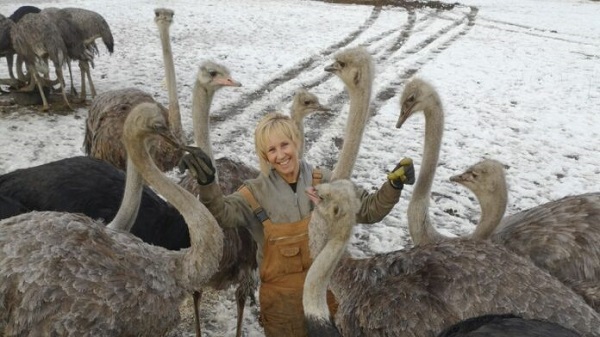Agriculture
Canadian Federation of Agriculture Awarded $560,000 for Single Portal Sustainability Sourcing

Canadian Federation of Agriculture Awarded $560,000 for Single Portal Sustainability Sourcing
Green certifications have become increasingly important in the food industry, as consumers look for confirmation that their food is being produced and processed in an environmentally friendly manner. In Canada, there has been a recent movement of concerned consumers looking for more transparency within the food industry. Organizations like Food Secure Canada advocate for a better food system that improves the connection between health, sustainability and agriculture.
In February 2020, the Minister of Agriculture and Agri-Food stated that the Canadian Federation of Agriculture would invest in a new sustainability initiative. The Canadian Federation of Agriculture is the largest farm organization in Canada, representing over 200,000 farms. The organization has played a critical role in advancing environmental sustainability practices within the food industry.
The Canadian Agri-Food Sustainability Initiative (CASI) will work with farmers, manufacturers, food processors and retailers to improve transparency in the Canadian food system. The initiative will promote sustainability through an integrated process that depends on data and collaboration to transform the food industry and improve relations with consumers.
The Canadian Food System
Canada is one of the top five exporters of food in the world. The Canadian agriculture and agri-food system generates over $100 billion in sales annually and employs over 2 million people. The agricultural food system is a significant player in Canada’s economic wealth and stability. However, like other large agricultural exporters — such as the United States — Canada has faced recent scrutiny over their production practices. Many large-scale and industrialized agriculture productions are harmful to the environment and detrimental to human health.
With such a large proportion of Canadian food exported, many domestic consumers distrust the public policies that lack transparency over the industry’s environmental impact and unsafe production practices. With the creation of the Candian Agri-Food Sustainability Initiative, the federal government hopes to facilitate improved sustainability throughout the food industry.
The Canadian Agri-Food Sustainability Initiative
The Canadian Agri-Food Sustainability Initiative includes a federal investment of $560,000. These funds will go toward the creation of an online forum that advances the analytic capabilities of producers and farmers. By creating a new network around sustainability, the project hopes to track the progress of sustainable practices in the Canadian food industry.
The initiative will also help producers and processors work together to certify products with sustainability labels that consumers are looking for. The Canadian Agri-Food Sustainability Initiative will rely on data analytics and real-time analysis of food production and processing to find solutions to unsustainable issues. From a consumer standpoint, it will increase trust in the use of food labels and regulate claims regarding the quality of various products.
Sustainability in the Agri-Food Industry
Canada’s agricultural system relies on the production of corn, potatoes, soybeans and commodity grains like wheat. Western parts of Canada have a higher production of beef, while the Eastern side focuses more on poultry. Unlike other top food exporters, Canada has been steadily growing the organic aspect of their production processes at a rate of 20% per year.
However, the percentage of land utilized for organic farming is meager — around 1.8 percent in 2017. Despite this, organic products still valued around $5.4 billion in both domestic and exported goods.
With such an economic reliance on the agricultural industry, the farm community, consumers and other concerned citizens are working together to ensure they manage Canadian soil more responsibly. According to the Canadian Federation of Agriculture, solutions like climate change research, bioeconomic strategy and the continuation of research and innovation within the industry will be key to future success.
Improving the Future of Canadian Agriculture
With this new initiative in place, agriculturists can have more confidence in growing organic products. Consumers, too, will be able to put their trust in the food industry, knowing the food they’re purchasing was grown sustainably.
https://www.todayville.com/what-the-usmca-might-mean-for-agriculture-and-biotechnology/

’m Emily Folk, and I grew up in a small town in Pennsylvania. Growing up I had a love of animals, and after countless marathons of watching Animal Planet documentaries, I developed a passion for ecology and conservation. You can read more of my work by clicking this link: Conservation Folks.
Agriculture
Canada Greenlights Mass Culling of 400 Research Ostriches Despite Full Recovery from Bird Flu Months Ago

 Nicolas Hulscher, MPH
Nicolas Hulscher, MPH
Federal court upholds CFIA’s reckless cull order—setting a dangerous precedent for the unscientific mass depopulation of genetically important animals.
In March, I interviewed Katie Pasitney of Universal Ostrich and Connie Shields to discuss the alarming implications of the Canadian Food Inspection Agency (CFIA) order to cull 400 research ostriches at Universal Ostrich Farm in British Columbia over bird flu:
Canada Orders Mass Culling of 400 Research Ostriches Over Bird Flu, Refuses to Test Surviving Birds for Natural Immunity
·The Canadian Food Inspection Agency (CFIA) has ordered the culling of 400 ostriches at Universal Ostrich Farm in British Columbia, citing concerns over H5N1 bird flu. However, this decision is not based on sound science and could have serious consequences for both food security and medical research.
Universal Ostrich Farm is a research facility focused on studying the unique antibody-producing capabilities of ostriches. Their research has demonstrated potential in neutralizing viruses, bacteria, and even COVID-19, making it an important contribution to medical science.
In December 2024, the CFIA claimed that two deceased ostriches—which had been lying outside for over 16 hours—tested positive for H5N1 via PCR testing. Just 41 minutes after receiving these results, the CFIA signed an order to cull the entire flock.
The CFIA initially granted the farm an exemption, recognizing the birds as “genetically important.” Later, without clear justification, they reversed this decision, ordering their destruction.
Despite the importance of this research, the CFIA has refused to conduct further testing on the birds and has banned the farm from conducting its own tests, under threat of heavy fines and possible imprisonment. Why is the Canadian government refusing to study the potential antibodies ostriches have developed against H5N1 bird flu?
On January 31, 2025, a court granted a temporary stay of execution, halting the cull. However, the CFIA is appealing this decision, which means the culling could still proceed.
Today, we have received news that the reckless mass cull order will proceed despite their ostriches having already recovered months ago and developed natural immunity against H5N1:

Official Announcement: Federal Court Decision in Universal Ostrich Farms Inc. v. Canadian Food Inspection Agency
Dear friends and supporters,
We are absolutely devastated to share today’s Federal Court decision, issued on May 13, 2025. The court ruled in favour of the Canadian Food Inspection Agency (CFIA), upholding their order to destroy our beloved ostriches and rejecting our plea to save them.
The court’s decision accepted the CFIA’s justification under the Health of Animals Act and their use of the Stamping-Out Policy, which mandates the destruction of animals to control disease outbreaks, regardless of their health status. The court confirmed the CFIA’s approach, prioritizing trade obligations over the welfare of our animals.
In addition, we’ve been ordered to pay $15,000 in CFIA’s legal costs. You can read the full decision here: (2025 FC 878). https://saveourostriches.com/wp-content/uploads/2025/05/JR-T-294-25-and-T-432-25-Final.pdf
We are heartbroken by this outcome and uncertain about the future of our farm. As we navigate this incredibly difficult time, we ask for your patience and continued support. If you are able, please consider making a donation to help us manage the financial and emotional toll this has taken.
Thank you,
Universal Ostrich Farm
http://SaveOurOstriches.com
This deeply misguided decision sets a dangerous precedent for the Canadian government to recklessly depopulate animals at will.
By upholding the CFIA’s reckless cull order, despite the ostriches’ recovery and natural immunity, the court has prioritized trade protocols over scientific inquiry, animal welfare, and the advancement of life-saving medical research.
Epidemiologist and Foundation Administrator, McCullough Foundation
www.mcculloughfnd.org
Please consider following both the McCullough Foundation and my personal account on X (formerly Twitter) for further content.
Agriculture
Canada is missing out on the global milk boom

This article supplied by Troy Media.
 By Sylvain Charlebois
By Sylvain Charlebois
With world demand soaring, Canada’s dairy system keeps milk producers locked out of growth, and consumers stuck with high prices
Prime Minister Mark Carney is no Justin Trudeau. While the team around him may be familiar, the tone has clearly shifted. His first week in office signalled a more data-driven, technocratic approach, grounded in pragmatism rather than ideology. That’s welcome news, especially for Canada’s agri-food sector, which has long been overlooked.
Historically, the Liberal party has governed with an urban-centric lens, often sidelining agriculture. That must change. Carney’s pledge to eliminate all interprovincial trade barriers by July 1 was encouraging but whether this includes long-standing obstacles in the agri-food sector remains to be seen. Supply-managed sectors, particularly dairy, remain heavily protected by a tangle of provincially administered quotas (part of Canada’s supply management system, which controls prices and limits production through quotas and tariffs to protect domestic producers). These measures stifle innovation, limit flexibility and distort national productivity.
Consider dairy. Quebec produces nearly 40 per cent of Canada’s milk, despite accounting for just over 20 per cent of the population. This regional imbalance undermines one of supply management’s original promises: preserving dairy farms across the country. Yet protectionism hasn’t preserved diversity—it has accelerated consolidation.
In reality, the number of dairy farms continues to decline, with roughly 90 per cent now concentrated in just a few provinces. On our current path, Canada is projected to lose nearly half of its remaining dairy farms by 2030. Consolidation disproportionately benefits Quebec and Ontario at the expense of smaller producers in the Prairies and Atlantic Canada.
Carney must put dairy reform back on the table, regardless of campaign promises. The sector represents just one per cent of Canada’s GDP, yet
wields outsized influence on policy, benefiting fewer than 9,000 farms out of more than 175,000 nationwide. This is not sustainable. Many Canadian producers are eager to grow, trade and compete globally but are held back by a system designed to insulate rather than enable.
It’s also time to decouple dairy from poultry and eggs. Though also supply managed, those sectors operate with far more vertical integration and
competitiveness. Industrial milk prices in Canada are nearly double those in the United States, undermining both our domestic processors and consumer affordability. These high prices don’t just affect farmers—they directly impact Canadian consumers, who pay more for milk, cheese and other dairy products than many of their international counterparts.
The upcoming renegotiation of CUSMA—the Canada-United States-Mexico Agreement, which replaced NAFTA—is a chance to reset. Rather than resist change, the dairy sector should seize the opportunity to modernize. This includes exploring a more open quota system for export markets. Reforms could also involve a complete overhaul of the Canadian Dairy Commission to increase transparency around pricing. Canadians deserve to know how much milk is wasted each year—estimated at up to a billion litres—and whether a strategic reserve for powdered milk, much like our existing butter reserve, would better serve national food security.
Global milk demand is rising. According to The Dairy News, the world could face a shortage of 30 million tonnes by 2030, three times Canada’s current annual production. Yet under current policy, Canada is not positioned to contribute meaningfully to meeting that demand. The domestic focus on protecting margins and internal price fairness is blinding the sector to broader market realities.
We’ve been here before. The last time CUSMA was renegotiated, Canada offered modest concessions to foreign competitors and then overcompensated its dairy sector for hypothetical losses. This created an overcapitalized industry, inflated farmland prices and diverted attention from more pressing trade and diplomacy challenges, particularly with India and China. This time must be different: structural reform—not compensation—should be the goal.
If Carney is serious about rebooting the Canadian economy, agri-food must be part of the conversation. But that also means the agriculture sector must engage. Industry voices across the country need to call on dairy to evolve, embrace change and step into the 21st century.
Dr. Sylvain Charlebois is a Canadian professor and researcher in food distribution and policy. He is senior director of the Agri-Food Analytics Lab at Dalhousie University and co-host of The Food Professor Podcast. He is frequently cited in the media for his insights on food prices, agricultural trends, and the global food supply chain.
Troy Media empowers Canadian community news outlets by providing independent, insightful analysis and commentary. Our mission is to support local media in helping Canadians stay informed and engaged by delivering reliable content that strengthens community connections and deepens understanding across the country.
-

 conflict2 days ago
conflict2 days agoOne dead, over 60 injured after Iranian missiles pierce Iron Dome
-

 Crime15 hours ago
Crime15 hours agoManhunt on for suspect in shooting deaths of Minnesota House speaker, husband
-

 Business4 hours ago
Business4 hours agoCarney’s European pivot could quietly reshape Canada’s sovereignty
-

 Alberta4 hours ago
Alberta4 hours agoAlberta’s grand bargain with Canada includes a new pipeline to Prince Rupert





